|
NOTE: All wines tasted at this event were provided by the sponsoring wineries. Please see my page ' Submissions, Reviews, Invitations & Disclaimers'. Here we go with Round Two of the Wine Bloggers Conference speed sipping, slurping, spitting and blogging extravaganza. As with the whites, we were given five minutes to absorb not just the wine itself but also the story of the winery and the process of the winemaking. A challenge, to be sure, but a good one. So I present to you the ten wines brought to our table, just as they were described at the time (with typos corrected to protect the innocent). 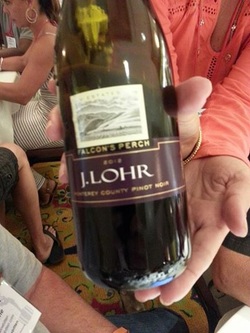 J. Lohr Pinot Noir J. Lohr Pinot Noir J Lohr Falcon's Perch Pinot Noir 2012 Award winning and inky $17. Slighty smokey- succulent silky strawberry. 13.5% alcohol means really drinkable. Can we say BBQ salmon with something chocolaty for afters?  Westerly from Santa Barbara County Westerly from Santa Barbara County Westerly Fletcher's Red 2010 Bordeaux style blend from Happy Canyon AVA . Black juicy berry meets licorice and black plum. Dark cocoa and earth and terrific balance of fruit acid and tannin keeps this rich and balanced. Sip alone or try with some braised short ribs. Winemaker hails from Harlan Estate. Need I say more? 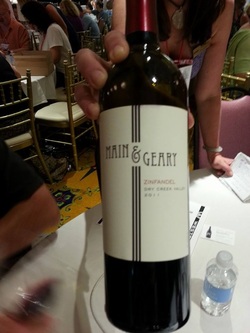 BevMo's own from Sonoma BevMo's own from Sonoma Main and Geary Dry Creek Zinfandel 2011 Big and plush palate zin from BevMo Private label series $19.95 and even less when you go to the 5 cent sale. Heat up the grill and get your party started with this very quaffable wine.  Not your typical Napa winery! Not your typical Napa winery! Cornerstone Cellars 'The Cornerstone’ Napa Valley 2011. Releasing this September & made to be aged for 10 years plus. Blend Cab Sauv/ Merlot/ Cab Franc. Everything is there: acidity, tannin and plummy cassis fruit blending all together. Balanced wine to savor in the years to come. Only 100 cases.  Little Winery, Big Hart. Little Winery, Big Hart. White Hart Pinot Noir 2012 Santa Lucia Highlands Central Coast 2012 40 year old vines in this cooler AVA brings out dark strawberry aromas with juicy red currants and subtle clove nutmeg spice. An elegant feminine Pinot made for sipping or cuisine. Delicious.  Photo Courtesy of Banfi Wines. Photo Courtesy of Banfi Wines. Banfi Centine Rosso 2012 Banfi Wines are in the house. Sangio-Merlot marriage is your everyday "let's have some wine with dinner" vino and at around $10-12 you can make this tasty little fellow your house wine. The soil is limestone dominant so we have great structure welding together cherry, berry and a bit of tar with great palate cleansing acidity. Bueno.  Saperavi is the variety - Marani Winery Saperavi is the variety - Marani Winery 2008 Satrapezo Saperavi from Georgia - the country! The grape is native to Georgia and the juice as well as the skin is red giving the wine a deep opaque hue. Rustic and earthy with plummy notes. Interesting. 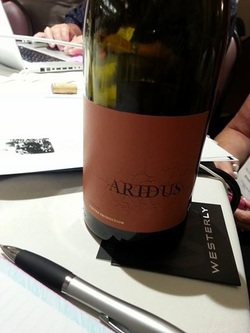 Aridus Syrah from Arizona Aridus Syrah from Arizona Aridus 2012 Syrah The winery is in Arizona but while they wait for the vines to produce they have sourced from the Russian River for this vintage. Dried sage herbs and black fruit with solid tannins would be good compliment to grilled meats and root veg.  Family Reserve Cabernet Sauvignon Family Reserve Cabernet Sauvignon Charles Krug Howell Mt Cabernet Sauvignon 2011 Broody and big with dark fruit and cocoa tobacco leaf. A touch of Petit Verdot and all French oak ups the anti on this voluptuous red. Prime Rib is calling.  Ottimino-Exclusively Zinfandel Ottimino-Exclusively Zinfandel Ottimino Vineyard 2011 Russian River Valley Zinfandel Cooler climate means longer, slower ripening so higher acidity and low alcohol- for a Zin!! Dark strawberry jam and cassis with black Dutch licorice, tealeaf and vanilla bean. Thinking some Tex-Mex. NOTE: All wines tasted at this event were provided by the sponsoring wineries. Please see my page ' Submissions, Reviews, Invitations & Disclaimers'.
0 Comments
NOTE: All wines tasted at this event were provided by the sponsoring wineries. Please see my page ' Submissions, Reviews, Invitations & Disclaimers'. How many wines can you taste, describe and put into the social media stratosphere in, say fifty minutes? If you had been attending the 7th Annual Wine Bloggers Conference in Santa Barbara County, CA a few weeks ago, you would have to say ten, because that's exactly what we did! The theory is this: bring together over 300 wine bloggers from around the world and seat them at large round banquet tables in the ballroom of the Santa Ynez Marriott. Every 5 minutes, have a winemaker or winery representative come to the table to pour wine samples and talk about the wines and the winery. The bloggers taste and assess, then Tweet, blog or Facebook their comments about the wine (plus any other interesting tidbits they can squeeze in) and the process is repeated. The action reached a fever pitch after about the second wine as everyone asked questions, swirled, and sipped while tapping away on smartphones, tablets and laptops. Day one was for Whites and Rosés. Sadly my table didn't see any pink wines but we reviewed an interesting array of whites. Here, with typos corrected, is a recap:  Bianchi Pinot Grigio 2012 Bianchi Pinot Grigio 2012 1) Bianchi Pinot Grigio 2012. Smooth but palate fresh. Dried grasses mingle with citrus ripe melon and somewhat cozy finish coming in at 13.7pc alc. Go Paso.
 Bandit Pinot Grigio 2012 Bandit Pinot Grigio 2012 3) Bandit 2012 Pinot Grigio Tetra Pack time. CA grapes-Napa Sonoma and Central Coast. Enviro friendly is great and at 8 bucks retail cud work for picnic. Light refreshing and crisp.  Leatitia Brut Cuvee NV Leatitia Brut Cuvee NV 4) Laetitia Brut Cuvee NV Sparkle time. Chard Pinot Noir and Pinot Blanc from Arroyo Grande. Cool green apple and soft peachy fizzle. Sustainable vineyards and great cool climate make good sparkling. Fun and frothy.  Consilience Viognier 2012 Consilience Viognier 2012 5) 2012 Consilience Viognier All local Santa Barbara AVA fruit vinified to make food friendly vino. Neutral French oak - 14 months gives soft vanilla spice, cinnamon toast to go with ripe plump apricot. Voluptuous as Viognier shud be but nice acidity keeps to that food friendly vibe and goal.  Rios de Chile Sauvignon Blanc 2013 Rios de Chile Sauvignon Blanc 2013 6) Rios de Chile 2013 Sauvignon Blanc Minimal intervention to keep varietal character. AM fog and proximity to the sea show in crisp clean granny smith apple and citrus peel notes. Grantic and sandy clay soils. Great food-seafod-salad wine. Try it- I will.  Jordan Russian River Chardonnay 2012 Jordan Russian River Chardonnay 2012 7) Jordan 2012 Russian River Chardonnay 40pc new French oak for 4 months keeps this approachable and food compatible. Really racy acidity enhances nuanced fruit. Super summer fare companion and might make your ABC friends change their minds.  Buttonwood 'Zingy' Sauvignon Blanc 2013 Buttonwood 'Zingy' Sauvignon Blanc 2013 8) Buttonwood Zingy Sauvignon Blanc 2013. All estate fruit - all stainless and cool ferment. Hence the name Zingy perhaps? Laid back aromas of green melon and crisp apples. Bring on the fried chicken and potato salad!  Aridus Malvasia Bianca 2013 Aridus Malvasia Bianca 2013 9) Aridus Malvasia Bianca 2013 Arizona's challenging climate and high elevations are no threat to Aridus Winery of Cochise County. Grapes from New Mexico. Neutral oak for few months but still highly aromatic. If you love Moscato you will flip for Malvasia - fruit salad in a glass with clean finish. 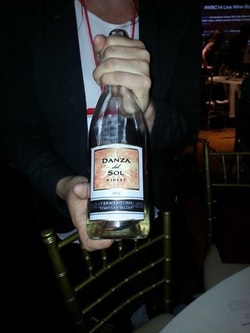 Danza del Sol Vermentino 2013 Danza del Sol Vermentino 2013 10) 2013 Danza del Sol Vermentino Temecula Valley. I have to like this or they will kick me out of my house right? Lime and tangerine on big nose. All stainless shows peachy palate. Come to Temecula and grab a glass on the patio. So, there you have it. Ten wine reviews in 50 minutes. It was noisy, challenging and a lot of fun. So much fun that we repeated the exercise the next day with reds! Stay tuned for part 2, coming soon.
NOTE: All wines tasted at this event were provided by the sponsoring wineries. Please see my page ' Submissions, Reviews, Invitations & Disclaimers'.  The San Diego International Wine Show was held last weekend, April 26 & 27 in Del Mar, California. I was invited to attend as both a member of the Press and as a presenter. Not quite sure which role was more fun! This was the third year for the event and this time they did, indeed, go international, with wineries and wines from Spain, Italy, Mexico, Portugal, Chile, Argentina and, of course, France. Local representation included Napa, Sonoma, Temecula and San Diego. For those of you who attended my seminar, "There's No Place Like Rhone!" I say thank you and hope you enjoyed such an abbreviated visit to this truly wonderful part of the wine world. Forty-five minutes goes way to fast. If you'd like to know more about the Rhone Valley, please visit my Student Resources page where you'll find all kinds of links and information on the wines and food of the region. I'd also like to thank KK LaFournaise for wrangling me into doing this, Donato Santarsieri, and Live Fit Magazine for their wonderful, live coverage of the event. Check out their YouTube page for a full recap. So, what should my topics be for next year?  One of the great perks of being involved with the wine industry, in all its many permutations, is the chance to taste and learn on a continual basis. Most of the offerings from wineries, especially larger producers or those affiliated with the more ‘corporate’ establishments, are focused on sales. After all this is the wine ‘business’ and without sales we would all in a sad state. But every now and again an invitation appears for a more ‘educational’ experience and these are the ones that get me excited. Such was the case last month when I attended the “Sommelier Series” event sponsored by Chalone Vineyards. The seminar was held at the stunning Lodge at Torrey Pines in La Jolla, CA. This elegant, craftsman-style resort is home, I’m told, to a legendary golf course but my focus was on the wines! 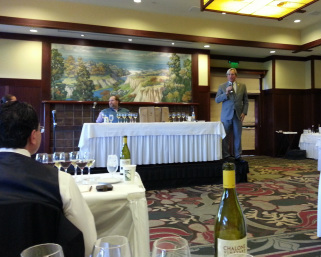 The workshop was conducted by Robert Cook, Winemaker for Chalone and Gilles de Chambure MS with a comparison tasting of several vintages from Chalone Vineyard and wines from Bourgogne.  Chalone Vineyards were first planted in 1919 by Frenchman Charles Tamm. It seems he was searching for soil that reminded him of his native Burgundy and found them in this limestone rich terrain in the shadow of Pinnacles National Monument .  Today, these are the oldest producing vineyards in Monterey County and produce award winning Chardonnay and Pinot Noir, just as Monsieur Tamm had dreamed of! In 1966, under owner/winemaker Dick Graff, Chalone set the standard for California Chardonnay and today, although it is owned by a large corporation (Diageo Chateau & Estate Wines), the wines are still crafted with respect for both the vineyard and the distinctive terroir. These wines certainly held their own when tasted against two delicious vintages from Burgundy and the passion of both gentlemen enhanced the experience. I shall be writing more extensively on the terroir, history and vintages of the Chalone AVA in the near future (more on that to come - stay tuned!). A big “Thank you” to Angela Bortugno and Lauren Watters of Chalone Vineyards for organizing a well orchestrated and classy event. Speaking to the other Sommeliers and educators, it was a terrific experience all around and Chalone should expect quite a few industry visitors in the months ahead. Disclosure: Wine tasting is a highly individual experience and, scientifically, none of us perceive wine in exactly the same way. The opinions expressed in this post are mine and mine alone and although the wines sampled were supplied by the designated wineries for review I describe them as I see them.  The connection between the grapevine and Greece is almost as old as wine itself. The ancient Greeks spread viticulture throughout the Ancient World and, for them, wine was not just a commodity but life and culture as well. So with this long history in mind, it was with great excitement that I joined with other members of the Temecula Wine Council to sample five wines kindly supplied by the “New Wines of Greece”. For many of us, when we here “Greek wine” we immediately think of ‘Retsina’, perhaps crafted in rustic old wineries from grapes we can’t pronounce! I am glad to report that nothing could be further from the truth. There has been a mammoth revival in the Greek wine industry, beginning in the late 20th century. Many local winemakers, who ventured to wine producing areas throughout the world, have returned to their roots, building shiny new production facilities that rival those of the ‘New World’. While embracing many new winemaking techniques there is desire to blend them with time-honored philosophies such as biodynamic and organic viticulture and the use of indigenous grape varieties. And so, we gathered at the Dorland Mountain Arts Colony, just outside Temecula, CA. The fresh air and solitude made for the perfect venue. Each of the six members attending the tasting were assigned one of the wines and asked to prepare a compatible dish for everyone to share. As you will discover, much of the fare paired well with many of the wines, showing just how food friendly and versatile these vintages turned out to be! First up was “Thema 2012” from Pavlidis Estate near the Macadonian town of Drama in northern Greece. A 50/50 blend of Sauvignon Blanc and Assyrtiko, (ah-SEER-tea-ko) the wine is a prime example of old meets new. The region of Macadonia has been a prime grape growing area for millennia and founder Christoforos Pavlidis has been cultivating both native and international varieties since 1998. The winery embraces modern viticulural practices on its 148 acres planted on a variety of soils in two vineyard sites. The winery itself is state of the art and visitors are welcome in their modern tasting room located on the “Wine Road of Dionysus”. The wine was delightful, with a subtle, elegant nose of lemon cream enchanced with touches of fresh green herbs. The zippy acidity and lime zest flavor accentuated the saltiness of the smoked salmon brought to pair with it. Our second vintage came to us from the home of the famous Greek varietal, Assyrtiko – the Aegean island of Santorini. 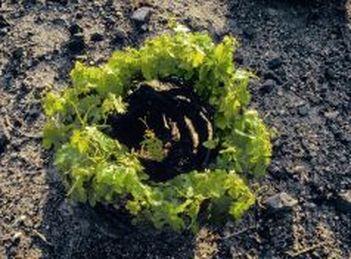 courtesy New Wines of Greece.com courtesy New Wines of Greece.com Domaine Sigalas Assyrtiko-Athiri 2011 is another example of traditional grape varietals truly showing their ‘terroir’ through more modern production. Domaine Sigalas was founded in 1991 and by 1998 had constructed a brand new winery/production center near Ola, in the northern part of the island. Their 47 acres of vineyards are planted on volcanic soils comprised of cinders, lava and pumice. They specialize in indigenous grape varieties grown in the traditional manner unique to Santorini. Vines are trained low to the ground, woven around itself like a round basket. This format, called a Kouloura meaning wreath or basket, protects the vines from strong winds and also shields the grape clusters from the intense, direct sunlight. The wine was a prime example of how the local white grapes of Greece have evolved to withstand the heat and sun of the Mediterranean without losing any of their distinctive, refreshing acidity. The clean, citrusy aromas were a true indication of what was found in the glass! Amazing, racy, mouth-watering acidity combined with a slight hint of sea air minerality and touches of lime blossoms. It was a terrific compliment to the steamed artichokes in olive oil, herbs and seasonings; the wine acting like a spritz of brightness, bringing out the flavor of the vegetable and freshness of the herbs. The last white of the evening also hailed from Macadonia - Ovilos Estate Biblia Chora 2010 a blend of a traditional native grape (50% Assyrtiko) and an international variety (50% Semillon). Vineyards here were first planted by the Phoenicians who found this “Golden Mountain” while in search of precious metals. Alexander the Great mined gold here to finance his expeditions and the Cult of Dionysus (or Bacchaus to the Romans) made their wines from Macadonian fruit. But enough history! The winery’s founders both studied in Bordeaux and returned to their homeland to make wine. The original 70 acres were planted in 1998 and now there are close to 350, all of which are farmed organically. A modern winery, built to resemble a grand Bordelais Chateau, was built in 2001 and their efforts have paid off; the wines have won numerous awards throughout the world.  This blend had a beautiful brilliant gold appearance, reflecting the 8 months the wine spent in oak. The aromas were clean and fresh with notes of golden apple, soft fruit blossom florals and a suggestion of dried apricot. The palate was supple and honeyed showing touches of mango and toasted pine nuts. It went very nicely with the food I had paired – grilled chicken Breast with herbed zucchini stuffing. The wine lifted the herbaceous notes in the dish and surprisingly, also complimented the artichokes and another traditional dish – Moussaka. Next up was the first red,“Xinomavro 2008 Urano” from Thumiopoulos Vineyards in Naoussa, also located in Macadonia. This winery is owned by Apostolos Thumiopoulos who, at the tender age of 31, is acknowledged as the ‘rising star’ in this famous wine growing region, Naoussa. His vineyards, all biodynamic, are planted on complex soils – a mixture of marl, schist and granite - in the southern part of the appellation. The winemaker embraces a minimally invasive philosophy when it comes to making wine, letting the grapes express themselves and showing their unique character, vintage to vintage. He uses naturally occurring yeast and little, if any, filtration to produce terroir driven results. This wine, made from the native Xinomavro (ksee-NO-mah-vro) varietal, showed aromas of dark strawberry jam laced with white pepper and soft touches of toasty rye bread. Dried tomato and a slightly spicy note lingered on the finish. The tannins and acidity were nicely balanced, which made it a wonderful compliment to the tasty ‘Boubaria’ – a traditional meat sausage of the area, bringing out spicy notes of cumin. It also paired beautifully with the Moussaka and some decadent spiced fig cakes! Our final wine of the evening kept us in the appellation of Naoussa and was also an expression of Xinomavro –“2007 Boutari Grande Reserve Naoussa.” The name Boutari is a familiar one around the world. It is the regions oldest winery – its history goes back 130 years – and has been an ambassador for Naoussa, the Xinomavro grape and Greek wine for almost as long. The vineyards are on the south-east slopes of Mount Vermio where the grapes enjoy lots of sunshine, generous rainfall and are shielded from the cold northerly winds. The marl soils, a mixture of limestone and clay, give the wines their rich body and ageing potential. The Grande Reserve is one of Boutari’s most collectable red wines and this vintage still has room to mature. Prune, plum and baking spices abound on the nose and palate with ripe dark berries and vanilla hanging on through the finish. The tannins are still firm and the acidity bright. Definitely a wine you would want to cellar or use a decanter or aerator to enjoy now. Also on hand was a fantastic Greek dip – feta, oregano, kalamata olives, and sun-dried tomatoes – served with pita chips that went with a variety of the evening’s wines. And lest we forget to mention the sinful chocolate brownies – frosted no less! As expected, they were a treat with both red wines and made a suitable ending to our feast. It was a terrific and enlightening group of wines that made me want to go out and find other “New Wines of Greece” to explore and enjoy. As they say in Greece “Yia Mas” - Here’s to Health! During these hot days of summer, I’m always on the prowl for crisp, refreshing whites and rosés. As I perused the shelves the other day, I came across a distinctively shaped bottle: tall and slender with the cross of Languedoc embossed on the neck.
This special bottle is indicative of the largest white producing area in the Languedoc region of Southern France – Picpoul de Pinet. A ‘Crus’ of the Coteaux de Languedoc, the area is named after the varietal Picpoul Blanc (aka Piquepoul Blanc or “Lip Stinger”) which has grown in these vineyards since at least the 17th century. The 3000 acres of vines are divided into two areas by a famous ancient Roman road called the “Via Domitienne” which, during that era connected the capital of Rome to Spain. Vineyards to the north are limestone, giving the grapes terrific acidity while those to the south lie on more flat, sandy deposits where the heat is tempered by Mediterranean breezes. 2011 La Domitienne Pique Poul, Picpoul de Pinet, Languedoc Bright and lively with aromas of ripe peaches, softly scented white blossoms and sea-spray, the palate shows deep lemon peel and touches of blanched almond all wrapped up with a refreshing saline minerality and bracing acidity. Naturally, the wine would be perfect with seafood and shellfish or perhaps a crisp salad but at our house the wine was paired with music – in vinyl form; Boomtown Rats “A Tonic for the Troops” and Audience “Lunch”. |
AuthorWine lover, educator and writer. Archives
March 2017
Categories
All
|


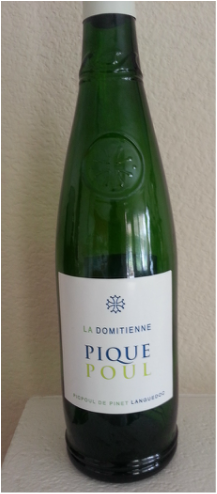
 RSS Feed
RSS Feed

